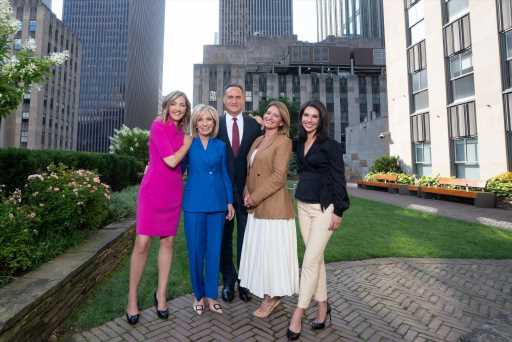Stop us if you’ve heard this one before: A prominent TV reporter walks into a bar…
A handful of the news anchors at MSNBC (yes, there are some left!) recently held a dinner to welcome Ana Cabrera, the former CNN journalist, to the network, where she has taken the reins of its 10 a.m. hour. Chris Jansing and Katy Tur, familiar faces to MSNBC viewers, were holding court, but Andrea Mitchell, a legendary Washington correspondent who has anchored an early afternoon show on MSNBC since 2008, was missing, due to making an appearance at Henry Kissinger’s 100th birthday.
“I thought a 100th birthday party for somebody would end early,” Mitchell confesses. “But it didn’t.”
Cabrera, Jansing, Tur, Mitchell have all found time to get together more frequently in recent weeks. They, along with their colleague, José Díaz-Balart, are playing a more critical role at MSNBC — but not in hours when such significance might be expected. On days when big events erupt, the network might group a few of them together, just as it does at night when Rachel Maddow, Nicolle Wallace, Alex Wagner and Lawrence O’Donnell gather to hash out the news cycle. The move injects primetime atmosphere into the late morning and early afternoon, sort of “turnin’ all the nighttime into the day,” as the rock group Dire Straits once sang.
MSNBC is largely known these days as a cable-news outlet that features programming with a hard-blue tilt. These five anchors, sandwiched between the end of “Morning Joe” at 10 a.m. and the start of Nicole Wallace’s “Deadline: White House” at 4 p.m., say they are forbidden from leaning that way or any other. “We are going to cover the stories as they come in,” says Tur, whose profile started gaining traction when she went on the road to cover the campaign of former President Donald Trump. Viewers can “sort out their views later on, but we are going to give you all of the information.”
Sometimes the news hours take MSBNC to places die-hard viewers might not expect. On Thursday, for example, Jansing led a commercial-free 90 minutes devoted to breaking coverage of indictments handed down against Hunter Biden, President Joe Biden’s son. “All of us are reporters,” says Jansing of the daytime team. “We know what it is like to be out there on the big story, and a lot of us have done it and we have done it under crazy circumstances and continue to do it. We are still out here.” On Friday, Cabrera opened her 10 a.m. hour, which kicks off in a studio devoted to virtual-reality graphics, with a 12-minute segment on the strike by United Auto Workers, interviewing three different sources on the matter. “I always frame my show, my day, my thinking around stories through this lens of what do our viewers care about? What do our audiences need to know?” she says.
MSNBC has expanded its opinion programming at the expense of traditional news hours in recent months, but Rashida Jones, its president, has tried to carve out a daytime weekday block devoted not to the progressive chatter that makes the network a popular destination for anti-Trumpers and liberals, but to what executives hope is seen as just-the-facts reportage. Her efforts, solidified recently by the arrival of Cabrera earlier this year, are meant to both assert MSNBC’s straight-news credentials, and bring new viewers inside the network’s orbit as media companies court broader audiences for coverage of 2024 race for the White House. The schedule MSNBC has designed, says Jones, will face the ultimate test as we do get into an election season.”
Why does MSNBC want to stay in the straight news game? It has cut news hours on weekends and expanded “Morning Joe” to four hours from three. What’s more, NBCUniversal keeps broadening a streaming service, NBC News Now, largely devoted to breaking news coverage, taking some of the pressure off MSNBC to serve as more of the same. Still, says Jones, such content has its place. “We also have to be in the game when live news is happening, and a lot happens during the day,” she says.
There is reason to go after the general audience, she says. People still want to find out what’s going on. Giving them exactly that keeps MSNBC’s enthusiasts from flipping elsewhere and serves to draw in new viewers who are eager to stay informed — and might find something else on the schedule that keeps them watching. “There was a period when the audience was trained to go to other places for certain kinds of stories,” says Jones. “There is no question now that when a general-news story happens, our audience knows to come to us because we are giving them a product that’s relevant, that’s important, that’s in the moment.”
Daytime shows on CNN and Fox News Channel continue to win more of the viewers that advertisers want — people between 25 and 54 — than MSNBC, but the network believes it is adding audience in daytime while rivals are harder pressed to do so. MSNBC in August saw its viewership among its 25-to-54 audience rise 23%, according to Nielsen, while overall audience was up 19%. In the same month CNN and Fox News saw declines in both categories.
Since the end of the coronavirus pandemic, TV executives have placed new focus on daytime and early evening, and it’s clear there are bigger audiences available during those hours. And news, as things turn out, can often be produced more effectively than ordering up other daytime staples, like soap operas or talk shows. The news division, after all, creates content throughout the day.
Some of the most-watched news programs on cable are Fox News‘ “The Five,” which airs at 5 p.m., and MSNBC’s “The Beat With Ari Melber,” which runs at 6. Both ABC News and NBC News have begun to fill daytime hours for their parent networks. The simple truth is that news is one of the last traditional formats standing in daytime, says Bill Hague, an executive vice president at Magid, a TV-industry consultancy. Thanks to streaming, “people tend to get their news before 7, maybe before 9,” and then begin to seek out a more bespoke media path. “Syndication is waning, all the talk shows, all the game shows.”
CNN recently reworked its daytime offering to include a “News Central” concept that relies on multiple anchors and souped-up graphics. Within a few weeks, however, the network said it would trim the six hours it devotes to the format to five, giving a mid-afternoon hour to Pamela Brown. “It’s an interesting concept,” says Jones, though “I think the audience has decided how they feel about it.”
If it seems as if MSNBC is stretching to offer hard news, it’s not. The network launched in 1996 as a direct competitor to CNN. And though it began to pivot in 2003 when it started offering Keith Olbermann’s pointed commentary, viewers still see news as part of the promise, says Mitchell. “From the beginning, when we went on the air, we were always hard news,” she says. During the daytime programs, says Jose Díaz-Balart, who leads the 11 a.m. hour and anchors Saturday’s broadcast of “NBC Nightly News,” “the leitmotifs running through all of those hours are service and journalism.”
MSNBC tried running opinion and perspective programs in the afternoon, placing Ronan Farrow and Joy Reid there as part of a broader effort to lean into progressive and lifestyle topics. But CNN at the time was doubling down on breaking-news stories like downed planes and troubled cruise ships — and gaining traction. News soon came back.
Still, MSNBC’s current focus likely means its daytime anchors won’t get a call to stick around for a broadcast in primetime, even if the news is seismic. The network is gathering audiences for a sort of all-hands-on-deck format that features many of its opinion personalities hashing out big headlines. Chris Hayes, Alex Wagner, Lawrence O’Donnell, Rachel Maddow, and, soon, Jen Psaki are the ones with primetime shows that get replayed in the wee hours of the morning.
“We might not be there for the primetime special, for the big election night, but we are doing giant news during the day,” says Tur, including coverage of the recent January 6 hearings in Congress. “ I don’t feel like I’m being denied anything personally.” The anchors said NBCUniversal has a wide assortment of news assets and they can often find a chance to do something extra. Tur did a four-part docuseries with colleague Jacob Soboroff. Earlier this month. Mitchell landed an exclusive interview U.S. Ambassador Linda Thomas-Greenfield at the border of Chad and Sudan. The full exchange aired on her MSNBC program.
MSBNC’s breaking-news mission has clearly changed. In a different era, Brian Williams would turn up to lead hours of coverage during moments of high import. When he left at the end of 2021, he took with him a singular job: Who would serve as the “face” of the network during such scenarios? MSNBC never replaced him in the role, but as it turns out, Williams has many successors.
Read More About:
Source: Read Full Article


